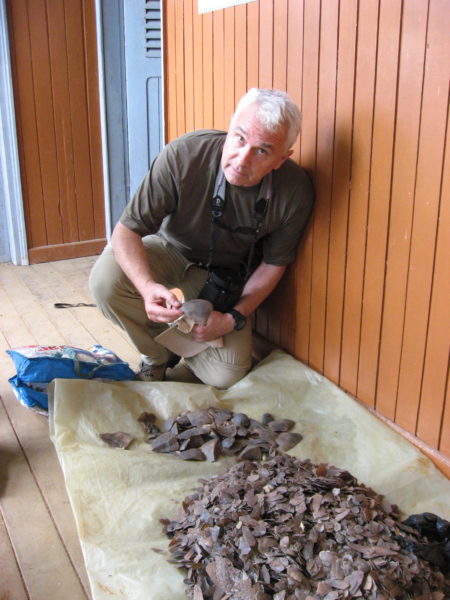
Giant pangolin, caught on camera in the Dja
Giant pangolins are poorly understood creatures. The species (Smutsia gigantea) is largely nocturnal, and lives in underground burrows in the lowland forests and savanna of tropical Africa. Their life span, range and habitat use are basically a mystery, and yet the species is severely threatened. Pangolins are one of the world’s most trafficked animals, killed for their scales and meat.
Understanding the giant pangolin’s natural history traits is a crucial step in building effective conservation plans, and protecting these animals from the ravages of poaching. These traits can’t be studied, however, without an understanding of how to locate and track giant pangolins (within the scope of a field research season and budget).
An international team of researchers affiliated with the Congo Basin Institute (CBI) has taken an important first step in achieving that, using camera traps and indigenous knowledge to locate and observe an active giant pangolin burrow. Their research was recently published in Tropical Conservation Science.
The CBI and Zoological Society of London (ZSL) team relied on information from members of the local Baka tribe, all experienced forest guides, to identify potential burrows. Camera traps were placed at nine different sites, and within two days the team had a hit: an adult male pangolin, pictured entering and exiting a burrow multiple times over a 25-day period. The study was conducted around the Bouamir Research Station, inside Cameroon’s Dja Biosphere Reserve.
This work can help inform future research on developing a spatial habitat use model for pangolins. This would help researchers understand things like how much habitat a pangolin needs, whether different habitat types support different population densities, and how to maintain viable pangolin populations.
It also raises some additional questions about giant pangolin behavior. The camera traps also caught small mammals – pouched rat and porcupine – entering and exiting the same burrow. Perhaps pangolins live in complex network of burrows, a sort of underground apartment complex. Or perhaps these species do not mind close company.
“This research will provide hard data on what pangolins require to be adequately protected in the wild,” said Thomas Bruce, ZSL’s lead on the study. “The images will bring much needed attention to the hugely charismatic, but rarely seen, species.”

